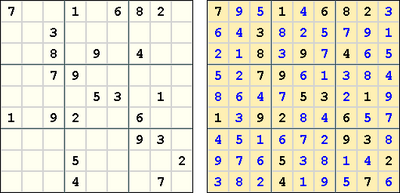Mirrored from Sudopedia, the Free Sudoku Reference Guide
Introduction
For the few people who have not heard of the Sudoku phenomenon, here is an introduction.
Contents |
A Brief History
A game called "Number Place" was designed by Howard Garns, and first published by Dell Magazines in 1979. The puzzle was introduced in Japan by Nikoli in 1984, who gave it the name "Sudoku", which is an abbreviation for the original Japanese name meaning "The Numbers must be Unique". The whole world adopted this new name, but in Japan, Nikoli owns the trademark, so other publishers in Japan call it Nanpure, the Japanese translation of Number Place. By the end of 2004, Sudoku appeared in The Times in Britain, brought to Europe by Wayne Gould, the founder of Pappocom. Many newspapers worldwide followed. Sudoku magazines can be found everywhere. Sudokus are published on the Internet on a daily basis. And many people have become addicted to it.

The Grid
A standard Sudoku puzzle consists of a 9x9 grid, with a total of 81 cells. Different sized grids exist in variations on Sudoku. Each position in the grid is called a cell. A cell can be empty, or filled with a digit. This digit can be any digit between 1 and 9. Zeros are not valid digits. When used, zeros represent empty cells. Despite the fact that numbers are used, there is no math involved in solving Sudokus. This is best illustrated by alternative versions, which use letters, colors, symbols or pictures. Digits are the easiest to communicate.
The Rule
You must place digits into the grid in such a way that every row, every column, and every 3x3 box contains each of the digits 1 through 9.
The Givens
A number of digits have been placed into the grid by the maker. These cannot be messed with. They are called givens, clues or fixed digits. They are placed in such a way that you can use logical reasoning to find the solution. A well-formed Sudoku has a single solution that can be found by reasoning, regardless of the complexity of that reasoning.
How to Proceed
You have now been introduced to the Sudoku phenomenon.
- Understand the Diagrams and Notations used by the Sudoku community.
- Get acquainted with the terminology.
- Learn the solving techniques.
